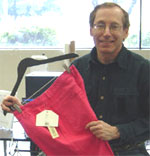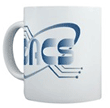June 5, 2007 - Meeting Preview |
Radio frequency identification or RFID is not a new technology. The earliest United States patents for passive RFID tags, e.g., without batteries or transmitters, go back to the early 1970s. Since then, the rapid advance of semiconductor technology has led to many common or pervasive applications of RFID. The simplest passive RFID tag consists of a semiconductor chip and an antenna. The maximum range of such tags is about thirty feet, although many applications use tags whose range is as short as an inch or two. An example of a short-range tag is the Speedpass which may be used to purchase gasoline. Some passive tags are battery-assisted to increase their range to as much as 100 feet. DACS members will have an outstanding opportunity to learn a great deal more about RFID technology from Dr. Paul A. Moskowitz, a Research Staff Member at the IBM T. J. Watson Research Center in Hawthorne, NY. Dr. Moskowitz is an expert on the physics of RFID. He holds a PhD. in physics and is a registered professional engineer. Dr. Moskowitz has been awarded over 70 United States patents. His work includes wireless applications, radio frequency identification (RFID), and automotive telematics. His latest work has been to develop a privacy enhancing RFID tag, the Clipped Tag, for consumer applications. The Clipped Tag has been listed by the Wall Street Journal in its 2006 Technology Innovation Awards. He has also been cited in 2007 by the RFID Gazette as one of the top influencers in the RFID industry. Dr. Moskowitz will discuss the technology behind RFID and how it works. He will show examples of RFID tags and discuss how RFID is used for consumer and industrial applications. Some of the uses he will discuss include electronic credit cards, pet identification and location, present and future uses of RFID for retail businesses, and the privacy implications of the technology. RFID tags may be viewed as electronic bar codes. However, the semiconductor chip which lies at the heart of the tag opens more applications. For example, many billions of dollars of counterfeit pharmaceuticals are sold each year. Losses in human suffering go beyond the monetary losses. Since each RFID tag may be made to be unique, RFID offers a method of authentication to help fight counterfeiting. If RFID tags and systems can be manufactured in large quantities at low cost, in the future they may be used to replace bar codes on retail items. Advantages that RFID systems have over bar codes are that the tags do not have to be aligned to a scanner and many tagged items may be read at once, up to hundreds of items per second. This use offers a means for quick check out at retail businesses. Another class of RFID tags is the active tag. These tags contain batteries and transmitters. They may be read at a range of up to 300 feet. These tags are used to locate people and objects. One oil company is using badges for employees as a safety device, so that in the case of an emergency employees may be located and accounted for. Dr. Moskowitz works with IBM consultants on RFID systems including RFID solutions for the health care industry. He represents IBM at the Hardware Action Group of EPCglobal, the standards group for the use of RFID in the retail supply chain. Do not miss this meeting! Bring your friends! DACS meetings are held at the Danbury Hospital auditorium. Activities begin at 6:30 p.m. with registration and casual networking. The meeting starts at 7:00 p.m. with a general question and answer period (Ask DACS) and a discussion of what’s new in technology followed by a short break. The featured evening presentation begins at 8:00. As a reminder, our General Meetings are free and open to the public so invite anyone you know who would be interested in this topic. |
Mugs and more, visit CafePress to order
 The Technology and Uses of Radio Frequency Identification (RFID) by Dr. Paul Moskowitz and Chris Novell Are you using Radio frequency identification? If you have an E-ZPass, you are. And if you don’t have an E-ZPass, chances are that you are making use of or benefiting from RFID some other way. RFID is a simple wireless technology in which RFID tags and readers exchange information; usually the tag sends its ID number to the reader upon request. The simplest passive tags have no batteries or transmitters. The tags receive their energy to operate from the radio signal sent by the reader. They communicate with the reader by reflecting the received radio wave back to the reader. The reflected wave is modulated by the tag in order to communicate the ID number of the tag.
The Technology and Uses of Radio Frequency Identification (RFID) by Dr. Paul Moskowitz and Chris Novell Are you using Radio frequency identification? If you have an E-ZPass, you are. And if you don’t have an E-ZPass, chances are that you are making use of or benefiting from RFID some other way. RFID is a simple wireless technology in which RFID tags and readers exchange information; usually the tag sends its ID number to the reader upon request. The simplest passive tags have no batteries or transmitters. The tags receive their energy to operate from the radio signal sent by the reader. They communicate with the reader by reflecting the received radio wave back to the reader. The reflected wave is modulated by the tag in order to communicate the ID number of the tag. 